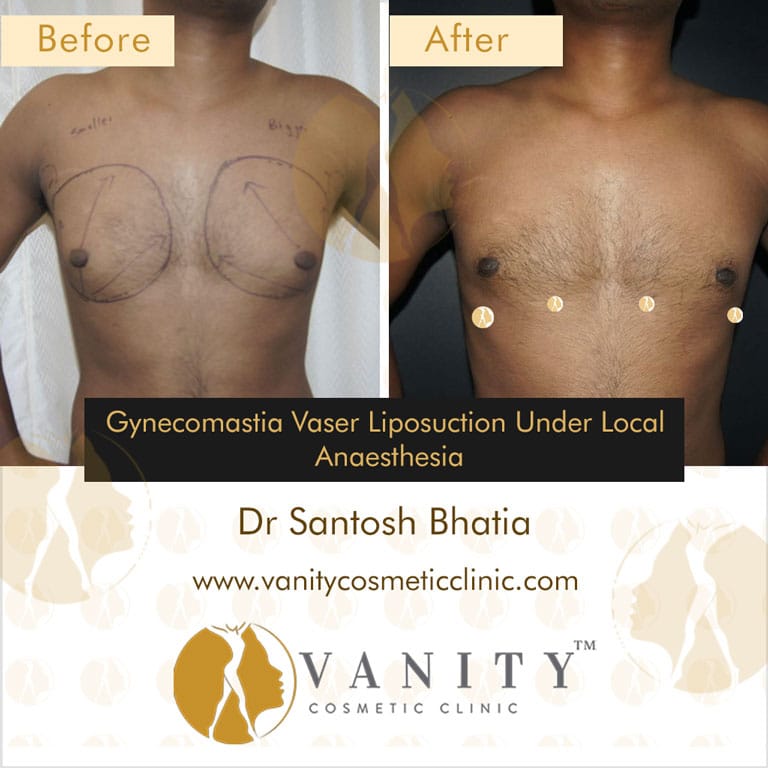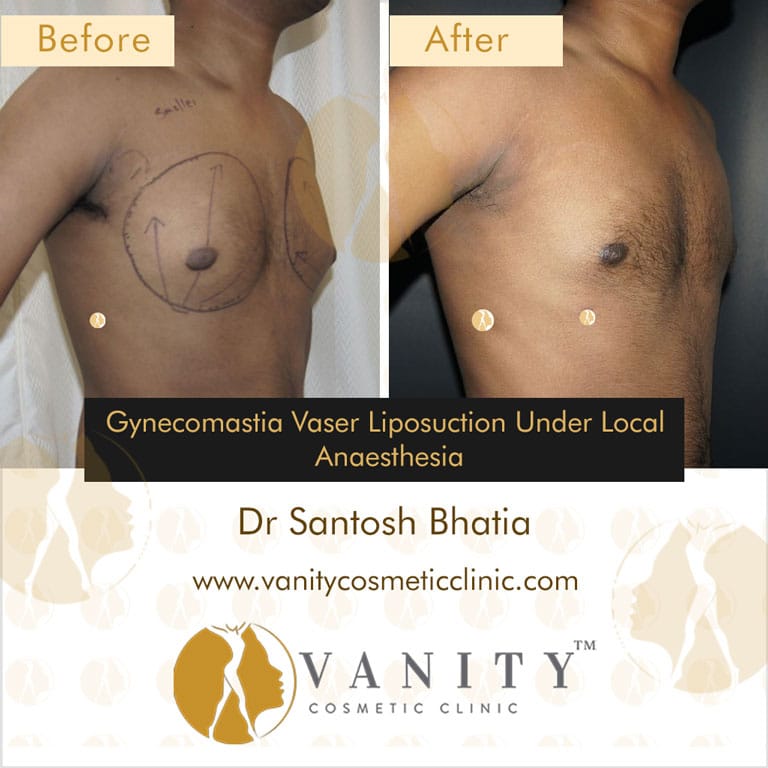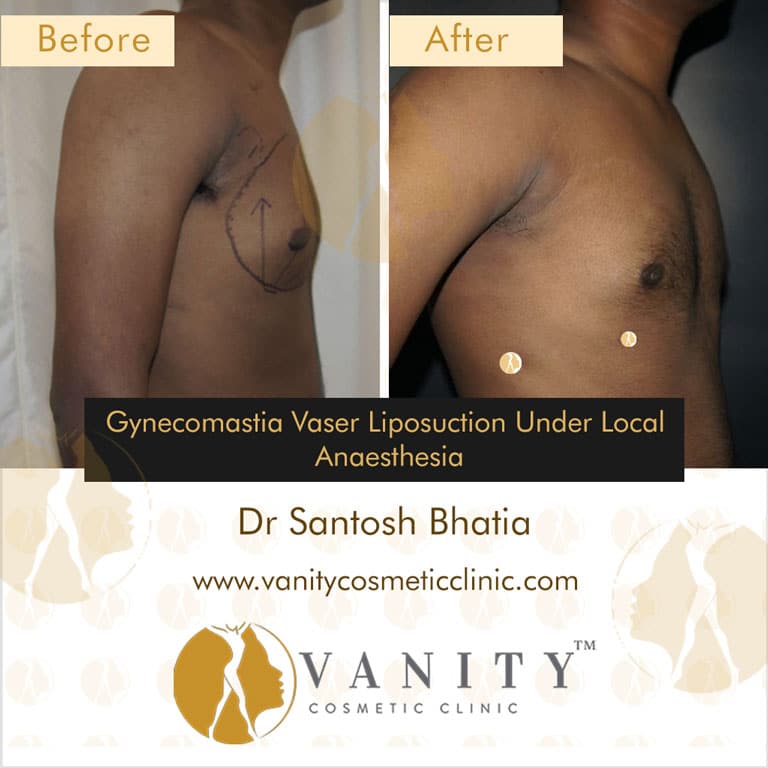The 29th of February 2020 was a significant milestone day for Vanity Cosmetic Clinic, Mumbai. Dr Santosh Bhatia, the Director of Vanity Cosmetic Clinic, Mumbai had the honour of presenting at the 5th Annual UKAAPS Meet in London on this day. This Meet was a professional conference for Aesthetic Plastic Surgeons from all over the world to interact with fellow practitioners and learn the new developments in the sphere of “Plastic and Cosmetic Surgery”.
Dr Santosh Bhatia is a Board-Certified, Plastic Surgeon who has worked wonders on patients in Mumbai, New York, Toronto, London, Chicago, Miami and Pune. His practice – Vanity Cosmetic Clinic is one of the best Plastic Surgery clinics in Mumbai.
In this blog, Dr Santosh Bhatia details out his talk on “Vaser Liposuction in Gynecomastia”. The blog covers the basics of what is Gynecomastia, what are the causes of Gynecomastia, how is it graded and how Vaser liposuction technique can give much better results for the patient.
What Is Gynecomastia?
Gynecomastia is the enlargement of the male chest due to hormonal imbalance within or due to hormone therapy. The hormones whose imbalance can cause Gynecomastia are estrogen and testosterone.
When the natural ratio of Estrogen to Androgens (including testosterone) is altered and there is more estrogen in the body, it results in increased male breast tissue.
Gynecomastia can happen to men of all ages – from newborns to adolescents to grown-men. It can affect one breast or both of them, depending on the hormonal imbalance.
It is a common misconception that gynecomastia is a result of obesity. Yes, there is a possibility that there is excess fat in the chest, but that is never the sole cause of gynecomastia.
In crude terms, Gynecomastia is also popularly referred to as “Man-boobs”. Apart from being a medical issue, Gynecomastia also has an adverse effect on the mental well-being of the patient. They are embarrassed and ashamed of their body and shut down on socializing.
What Are The Causes Of Gynecomastia?
Dr. Santosh Bhatia, the Board-certified Plastic Surgeon of Vanity Cosmetic Clinic has revealed the causes of Gynecomastia. According to Dr. Bhatia in 25% cases, the causes of Gynecomastia are unknown.
In other cases, strong medications like methadone, spironolactone, HIV medication, cancer chemotherapy, hormone therapy for prostatic cancer, ulcer medication, CCB, antifungal medication, antibiotics and antidepressants tend to upset the natural hormonal balance and lead to Gynecomastia.
Serious medical conditions like liver disease, renal failure, testicular tumours and lung carcinoma can lower the testosterone in the body and lead to breast tissue growth.
What Are The Physiological Characteristics of Gynecomastia In Different Age Groups?
Although this may sound bizarre, many newborn babies of both sexes show breast development in the first week of birth. Dr Santosh Bhatia, the Board-certified Plastic Surgeon and Director of Vanity Cosmetic Clinic, Mumbai explains that this is common and generally resolves on its own within 2-3 weeks of birth.
Gynecomastia in adolescents usually starts at 10 to 12 years of age and commonly goes away after 18 months. Sometimes in cases like these, doctors may ask patients to simply calm down and let the body do its job on its own.
In the older age groups, the declining testosterone levels and an increase in the fibrofatty tissue lead to senile Gynecomastia. When the human body is deprived of adequate nutrition, testosterone levels drop, while the adrenal glands continue to produce estrogens, thereby causing hormonal imbalance.
What Are The Different Grades Of Gynecomastia?
Gynecomastia has been divided into different grades based on the physical characteristics it exhibits. This classification is crucial in helping doctors decide the necessary course of action.
- Grade 1: Small enlargement without skin excess
- Grade 2A: Moderate enlargement without skin excess
- Grade 2B: Moderate enlargement with minor skin excess
- Grade 3: Marked enlargement with excess skin, mimicking female breast ptosis
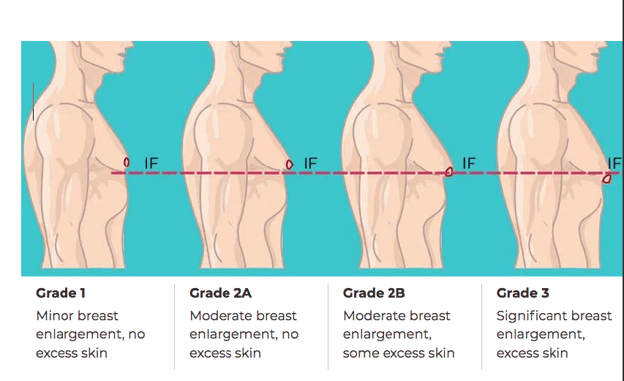
How Should A Doctor Evaluate A Patient With Gynecomastia?
Dr Santosh Bhatia has always given the highest priority to one-on-one consultations with the patients. The consultations give him the opportunity to understand not only the physical or medical problem but also the frame of mind Gynecomastia has put the patient in. Vanity Cosmetic Clinic, Mumbai always recommends taking the time to understand the patient’s needs, goals and desires from the surgery during the consultation.
In the case of Gynecomastia patients, Dr Santosh Bhatia recommends using the following checklist to ensure a thorough evaluation:
- Obtain a complete medical history of the patient and read through it carefully.
- Conduct a thorough physical evaluation of the patient which includes –
- Examine the male breast tissue via palpation for signs of for breast cancer and pseudo gynecomastia.
- Evaluation of penile size & development
- Assessment of testicular masses ( suspicious of testicular cancer) and secondary sexual characteristics
- Check whether the Gynecomastia is unilateral or bilateral.
- Prescribe Liver Function Test to rule out liver pathology.
- Check for rare disorders like Klinefelters syndrome too.
Dr Santosh Bhatia, the Board-certified Plastic Surgeon of Vanity Cosmetic Clinic, Mumbai also uses this time to resolve all the doubts in the mind of the patient. He explains the surgery, risks related to it and how it will benefit the patient in detail. At the end of the consultation, both Dr Bhatia and the patient are on the same page.
How Should The Patient Prepare For Gynecomastia Surgery?
Vanity Cosmetic Clinic, Mumbai doesn’t expect the patient to put in any special efforts for the preparation of this surgery. But it is the duty of the patient to undergo all medical tests that Dr Santosh Bhatia prescribes.
As part of the preparation, the patient should refrain from taking any medicine without prior approval from the surgeon. Consumption of nicotine should be stopped in the days leading up to the surgery.
The surgeon should explain why he has asked the patient to follow certain guidelines in the days preceding the surgery. This ensures that all the guidelines are followed without fail.
What Is Dr Santosh Bhatia’s Gynecomastia With Vaser Liposuction Surgery Technique?
Dr Santosh Bhatia’s vast work experience and association with the best plastic surgeons in the world have allowed him to develop a more effective surgical technique when dealing with Gynecomastia. In this section, you will find information in two parts – the first part will cover the traditional excision procedure and the second part will cover Dr Bhatia’s Vaser Liposuction procedure.
- PART I: The Excision Technique
The excision technique is the traditional procedure to remove excess breast tissue and resolve the problem of Gynecomastia. In this technique, the surgeon will make an incision around the nipple-areola complex and remove the excess glandular tissue and excess skin from the male breast.
Excision technique is also useful if the areola will be reduced or the nipple will be repositioned to a more natural male contour. Incision patterns vary depending on the specific conditions and surgical preference.
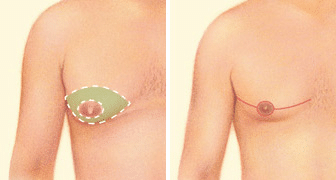
This technique is not preferred by Dr Santosh Bhatia because it leaves a marked scar on the chest of the patient. He believes the patients want to opt for Gynecomastia surgery not only because it will correct the problem but also because it will be a subtle, natural-looking outcome. So a visible scar defeats the purpose altogether.
- PART II: Dr Santosh Bhatia’s Vaser Liposuction Technique
Before the surgery, Dr Santosh Bhatia draws topographical markings on the patient’s chest. This ensures the gland is marked well in advance and surgery is performed more efficiently.
The administration of local or general anaesthesia is the next step in the surgery. The type of anaesthesia will be decided by Dr Santosh Bhatia and may vary from case to case.
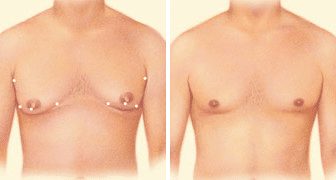
Once the patient is comfortable, the Vaser Liposuction surgery for Gynecomastia begins.
Dr Bhatia keeps the Tumescent Infiltration solution (cocktail) ready before the surgery itself. It is a combination of 1 litres Ringer lactate + 2cc Adrenaline+ 20cc Xylocaine 2%+10cc Soda Bicarbonate+ 1 amp Hyalase.
According to the calculations of Dr Santosh Bhatia, 1 litre of solution per breast is prepared with a goal of removing 250-300 gms of gland per breast. To achieve this the next step is very crucial.
The Tumescent solution is infiltrated in the area which needs to be Vasered. Now Dr Santosh Bhatia likes to over infiltrate the gland. His logic being that when a balloon is overinflated even a simple pin can burst it easily. Similarly when the gland is over infiltrated the fatty tissue inside breaks down easily or melts away quickly when the Vaser liposuction is performed.
The next part involves using the Vaser machine at 90% power with a single ring cannula. This is a powerful setting hence one should not be very superficial else chances of skin damage /burns can be high. Typically 2-4 minutes of Vasering is sufficient for Gynecomastia surgery.
Now Dr Santosh Bhatia, the Board-certified Plastic Surgeon of Vanity Cosmetic Clinic, Mumbai proceeds further and starts the actual liposuction. The two previous steps of over infiltration of tumescent solution and Vaser make liposuction easy and quick.
The use of Vaser ensures that the gland has melted away under the high power and can be suctioned out like fatty tissue. This eliminates the need for an excision altogether.
Liposuction or debulking the major portion of the gynecomastia is done using a 3.7 -4.6 mm of cannula. As with any other body area, the debulking initially using larger cannulas eases the finesse required at the end of the procedure. However, warns Dr Bhatia one must be cautious so as to not cause any severe depressions.
The next aspect of the surgery is feathering. Feathering is a surgical technique performed by the sensory hand of the surgeon to achieve a smooth transition from the area that is liposuctioned and the untreated area. Dr Santosh Bhatia believes if feathering is done with precision then a lot of times it eliminates the need for excision.
Post debulking one should feather or tunnel the entire marked area to be liposuctioned so as to redistribute the fat/breast tissue as reduce chances of unevenness.
In the next step again Dr Santosh Bhatia’s technique varies from the majority of surgeon’s techniques. In his unique technique, Dr Bhatia reassesses the remaining gland post feathering. Most surgeons would opt for excision in this scenario, but Dr Bhatia opts for the pinch technique with a 3 mm cannula. Of course, extra care needs to be taken here to avoid acute depression and asymmetry.
In the final reassessment, once again evaluation is necessary to see if any tunnelling/redistribution of tissue is required or not. Also, checking of whether repositioning of the nipple is necessary needs to be evaluated at this stage.
A word of caution for Grade 1 Gynecomastia Surgery – be careful to not over suction the gland because it may lead to an inversion of the nipple.
Dr Santosh Bhatia’s Vaser Liposuction technique is a breakthrough in Gynecomastia surgery because patients are happy to undergo a surgery which is almost scarless. The results are a well-contoured flat chest and a happy patient!
What Do Dr Santosh Bhatia’s Patients Experience During Recovery?
After the surgery, a pressure garment (like a corset) has to be mandatorily worn by the patient for 3 weeks after the surgery and at least for 12 hours after that.
The results are generally visible after 3 months and if liposuction is performed, a single stitch is required which is almost invisible.
As the entire breast tissue has been removed, the possibility of gynecomastia returning is very rare and the results of the surgery are long-lasting.
Patients do not experience a lot of pain or discomfort post this surgery. They are comfortable and resume their daily activities in a week’s time. Of course, no heavy exercising is permitted for a minimum of 4-6 weeks.
Are There Any Risks Associated With Gynecomastia Surgery?
The risks and complications that are associated with Gynecomastia are very rare. However, some of them include:
1) Loss of nipple sensation
2) Consistent pain
3) Seroma (collection of fluid)
4) Hematoma ( collection of blood)
5) Chances of infection
Proper care must be taken at all times in order to avoid these risks from turning into a reality.
Conclusion:
Dr Santosh Bhatia’s talk at UKAAPS was a big success! Aesthetic Surgeons from all over the world appreciated his insights into this technique. As a Board-certified Plastic Surgeon of Vanity Cosmetic Clinic Mumbai, Dr Santosh Bhatia not only focuses on aesthetic, subtle and natural-looking results but also on results that give the patient mental satisfaction and boosts his confidence.
Thank you for reading this blog.
In case of queries please get in touch with Dr. Santosh Bhatia via [email protected]
